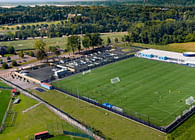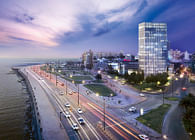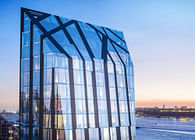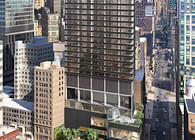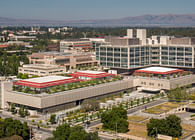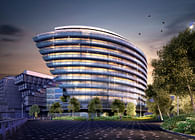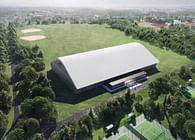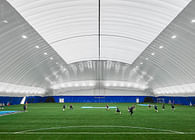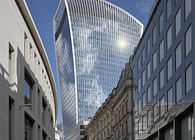
New York, NY
The University of California, San Francisco (UCSF), issued a Request for Proposal in 2005 for a new laboratory, the Institute for Regeneration Medicine Building (IRM), and commissioned Rafael Viñoly Architects for the project after a competitive interview process. The firm was chosen for its range of laboratory experience, the strength of its previous successful work with the university, and the researchers’ belief that the firm would bring the most creative solution to the design challenge. RVA served as the Design Architect, and assisted the Design-Build team of DPR Construction / SmithGroup during construction.
Given that the building was to be located on a steeply sloping site at the foot of Mount Sutro, the client expected a vertical building organization, which might not have been well fitted to the institute’s research needs. Stemming from the belief that a horizontal scheme is best for interior lab organization and for research collaboration, RVA found a way to plan a horizontal building despite the challenging site. The main floor functions as one continuous laboratory divided into four split levels, each stepping down a half-story as the building descends the forested mountain slope, and each topped by an office cluster and a green roof. Exterior ramps and stairs, taking advantage of the temperate climate, provide continuous circulation between all levels, and the facility connects to three nearby research and medical buildings via a pedestrian bridge. The building structure is supported by cantilevered steel columns resting on concrete piers, minimizing site excavation and incorporating seismic base isolation to absorb earthquake forces.
Inside the building, the transitions between the split levels are designed as hubs of activity. Break rooms and stairs located at these interfaces increase the potential for chance interaction, and interior glazing maximizes visual connectivity between the lower labs and the upper offices. To further promote collaboration, the laboratories occupy a horizontal open-floor plan, with a flexible, custom-designed casework system that enables the rapid reconfiguration of the research program. Abundant south-facing glazing fills the open laboratories and offices with natural light and views of the wooded slope of Mount Sutro nearby.
In accordance with university policy, the project will be certified LEED Silver and will follow Labs21 environmental performance criteria. The IRM achieves these sustainability measures most notably with landscaped green roofs that minimize heat island effect, control storm water runoff, insulate the building, and provide an outdoor amenity for occupants.
Status: Built
Location: San Francisco, CA, US
